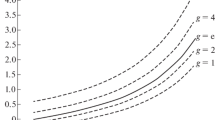Abstract.
A general scheme is given for the solution in a least-squares sense of the geodetic boundary value problem in a spherical, constant-radius approximation, both uniquely and overdetermined, for a large class of observations. The only conditions are that the relation of the observations to the disturbing potential is such that a diagonalization in the spectrum can be found and that the error-covariance function of the observations is isotropic and homogeneous. Most types of observations used in physical geodesy can be adjusted to fit into this approach. Examples are gravity anomalies, deflections of the vertical and the second derivatives of the gravity potential.
Similar content being viewed by others
Author information
Authors and Affiliations
Additional information
Received: 3 November 1999 / Accepted: 25 September 2000
Rights and permissions
About this article
Cite this article
van Gelderen, M., Rummel, R. The solution of the general geodetic boundary value problem by least squares. Journal of Geodesy 75, 1–11 (2001). https://doi.org/10.1007/s001900000146
Issue Date:
DOI: https://doi.org/10.1007/s001900000146



